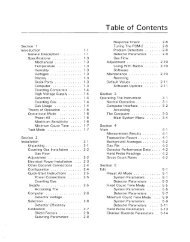Rad Data Handbook 20.. - Voss Associates
Rad Data Handbook 20.. - Voss Associates
Rad Data Handbook 20.. - Voss Associates
You also want an ePaper? Increase the reach of your titles
YUMPU automatically turns print PDFs into web optimized ePapers that Google loves.
Positron Emitters Beta+ Energy and % Abundance<br />
Half-life MeV (%)<br />
C-11 <strong>20.</strong>3 m 0.960 (99.8%)<br />
N-13 9.97 m 1.199 (99.8%)<br />
O-15 122 s 1.732 (99.9%)<br />
F-18 1.83 h 0.634 (96.7%)<br />
Na-22 2.605 y 0.546 (89.8%)<br />
Al-26 7.3E5 y 3.210 (100%)<br />
V-48 15.98 d 0.697 (50.1%)<br />
Mn-52 5.591 d 2.633 (94.9%)<br />
Co-56 77.3 d 1.458 (19.0%)<br />
Ni-57 35.6 h 0.737 (7.0%), 0.865 (35.3%)<br />
Co-58 70.88 d 0.475 (14.9%)<br />
Cu-62 9.74 m 2.926 (97.2%)<br />
Zn-65 243.8 d 0.330 (1.4%)<br />
Ga-68 67.7 m 0.822 (1.2%), 1.899 (89.1%)<br />
As-74 17.8 d 0.945 (26.1%), 1.540 (3.0%)<br />
Rb-82 1.26 m 2.601 (13.1%), 3.378 (81.8%)<br />
Several of the positron emitters are useful in PET studies.<br />
That usefulness is somewhat offset by the cost of producing<br />
the radionuclides and the added complexity of radiation<br />
protection. For all of the positron emitters the energy of the<br />
Beta+ must be considered. Refer to the table of Beta Dose<br />
Rates for estimates of beta+ radiation exposure. Also,<br />
consider the annihilation photons when the positron comes<br />
into contact with a beta-, annihilating their masses and<br />
producing two 511 KeV photons. These photons present an<br />
external radiation hazard. For the patient undergoing a PET<br />
scan the combination of the positron energy and the photon<br />
energy must be considered.<br />
56<br />
Positron Emitters Beta+ Energy and % Abundance<br />
Half-life MeV (%)<br />
C-11 <strong>20.</strong>3 m 0.960 (99.8%)<br />
N-13 9.97 m 1.199 (99.8%)<br />
O-15 122 s 1.732 (99.9%)<br />
F-18 1.83 h 0.634 (96.7%)<br />
Na-22 2.605 y 0.546 (89.8%)<br />
Al-26 7.3E5 y 3.210 (100%)<br />
V-48 15.98 d 0.697 (50.1%)<br />
Mn-52 5.591 d 2.633 (94.9%)<br />
Co-56 77.3 d 1.458 (19.0%)<br />
Ni-57 35.6 h 0.737 (7.0%), 0.865 (35.3%)<br />
Co-58 70.88 d 0.475 (14.9%)<br />
Cu-62 9.74 m 2.926 (97.2%)<br />
Zn-65 243.8 d 0.330 (1.4%)<br />
Ga-68 67.7 m 0.822 (1.2%), 1.899 (89.1%)<br />
As-74 17.8 d 0.945 (26.1%), 1.540 (3.0%)<br />
Rb-82 1.26 m 2.601 (13.1%), 3.378 (81.8%)<br />
Several of the positron emitters are useful in PET studies.<br />
That usefulness is somewhat offset by the cost of producing<br />
the radionuclides and the added complexity of radiation<br />
protection. For all of the positron emitters the energy of the<br />
Beta+ must be considered. Refer to the table of Beta Dose<br />
Rates for estimates of beta+ radiation exposure. Also,<br />
consider the annihilation photons when the positron comes<br />
into contact with a beta-, annihilating their masses and<br />
producing two 511 KeV photons. These photons present an<br />
external radiation hazard. For the patient undergoing a PET<br />
scan the combination of the positron energy and the photon<br />
energy must be considered.<br />
56<br />
Positron Emitters Beta+ Energy and % Abundance<br />
Half-life MeV (%)<br />
C-11 <strong>20.</strong>3 m 0.960 (99.8%)<br />
N-13 9.97 m 1.199 (99.8%)<br />
O-15 122 s 1.732 (99.9%)<br />
F-18 1.83 h 0.634 (96.7%)<br />
Na-22 2.605 y 0.546 (89.8%)<br />
Al-26 7.3E5 y 3.210 (100%)<br />
V-48 15.98 d 0.697 (50.1%)<br />
Mn-52 5.591 d 2.633 (94.9%)<br />
Co-56 77.3 d 1.458 (19.0%)<br />
Ni-57 35.6 h 0.737 (7.0%), 0.865 (35.3%)<br />
Co-58 70.88 d 0.475 (14.9%)<br />
Cu-62 9.74 m 2.926 (97.2%)<br />
Zn-65 243.8 d 0.330 (1.4%)<br />
Ga-68 67.7 m 0.822 (1.2%), 1.899 (89.1%)<br />
As-74 17.8 d 0.945 (26.1%), 1.540 (3.0%)<br />
Rb-82 1.26 m 2.601 (13.1%), 3.378 (81.8%)<br />
Several of the positron emitters are useful in PET studies.<br />
That usefulness is somewhat offset by the cost of producing<br />
the radionuclides and the added complexity of radiation<br />
protection. For all of the positron emitters the energy of the<br />
Beta+ must be considered. Refer to the table of Beta Dose<br />
Rates for estimates of beta+ radiation exposure. Also,<br />
consider the annihilation photons when the positron comes<br />
into contact with a beta-, annihilating their masses and<br />
producing two 511 KeV photons. These photons present an<br />
external radiation hazard. For the patient undergoing a PET<br />
scan the combination of the positron energy and the photon<br />
energy must be considered.<br />
56<br />
Positron Emitters Beta+ Energy and % Abundance<br />
Half-life MeV (%)<br />
C-11 <strong>20.</strong>3 m 0.960 (99.8%)<br />
N-13 9.97 m 1.199 (99.8%)<br />
O-15 122 s 1.732 (99.9%)<br />
F-18 1.83 h 0.634 (96.7%)<br />
Na-22 2.605 y 0.546 (89.8%)<br />
Al-26 7.3E5 y 3.210 (100%)<br />
V-48 15.98 d 0.697 (50.1%)<br />
Mn-52 5.591 d 2.633 (94.9%)<br />
Co-56 77.3 d 1.458 (19.0%)<br />
Ni-57 35.6 h 0.737 (7.0%), 0.865 (35.3%)<br />
Co-58 70.88 d 0.475 (14.9%)<br />
Cu-62 9.74 m 2.926 (97.2%)<br />
Zn-65 243.8 d 0.330 (1.4%)<br />
Ga-68 67.7 m 0.822 (1.2%), 1.899 (89.1%)<br />
As-74 17.8 d 0.945 (26.1%), 1.540 (3.0%)<br />
Rb-82 1.26 m 2.601 (13.1%), 3.378 (81.8%)<br />
Several of the positron emitters are useful in PET studies.<br />
That usefulness is somewhat offset by the cost of producing<br />
the radionuclides and the added complexity of radiation<br />
protection. For all of the positron emitters the energy of the<br />
Beta+ must be considered. Refer to the table of Beta Dose<br />
Rates for estimates of beta+ radiation exposure. Also,<br />
consider the annihilation photons when the positron comes<br />
into contact with a beta-, annihilating their masses and<br />
producing two 511 KeV photons. These photons present an<br />
external radiation hazard. For the patient undergoing a PET<br />
scan the combination of the positron energy and the photon<br />
energy must be considered.<br />
56













